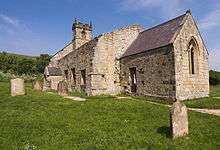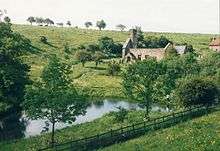Wharram Percy
Wharram Percy is a deserted medieval village (DMV) near Malton, North Yorkshire,[1] on the western edge of the chalk Wolds of North Yorkshire, England. It is about 1 mile (1.6 km) south of Wharram-le-Street and is signposted from the B1248 Beverley to Malton road. Wharram Percy was part of the East Riding of Yorkshire until the 1974 boundary changes.

Wharram Percy is a significant English DMV, although there are remains of others in a similarly good state of preservation.
The earthworks of the village have been known for many years, and outlines of house platforms were drawn onto the first Ordnance Survey six-inch maps of Yorkshire published in 1854.[2] The site was researched each summer by combined teams of archaeologists, historians and even botanists, from about 1950 to 1990 after it was singled out for study in 1948 by Professor Maurice Beresford of the University of Leeds.[3]
History
Although the site seems to have been settled since prehistory, the village appears to have been most active from the 10th to the 12th centuries. The Domesday Book of 1086 records it as 'Warran' or 'Warron'. The suffix 'Percy' stems from the prominent, aristocratic family that owned the area during the Middle Ages.
The Black Death of 1348–49 does not seem to have played a significant part in the desertion of Wharram Percy, although the large fall in population in the country as a whole at that time must have encouraged relocation to larger settlements.
In 1402 or 1403, the Percy family exchanged their holdings in the area with the Hylton family. Following changes in prices and wages during the 15th century, pastoral farming (particularly sheep) was more profitable for landowners than cereal farming. Over the century following, the Hylton family devoted more and more land to sheep, as their employment of agricultural labour decreased. During the early 16th century, the last residents of Wharram Percy were evicted and their homes were demolished to make room for more sheep pasture.[4]

Present site
The site is now in the care of Historic England. Although only the ruined church is easily visible above ground, much more of the village layout can be seen in the surrounding fields. English Heritage has installed information panels around the site, and provided an audio tour downloadable in mp3 format from the English Heritage website.
The site has been subect to archaeological investigations since the 1950s.[5] In 2002, English Heritage (now called Historic England) undertook an archaeological investigation and analytical field survey of Wharram Percy.[6] A study of a sizeable collection of human skeletal remains excavated from the churchyard of the deserted village, published in 2004, reveals details of disease, diet and death in the rural medieval community.[7] This used the latest scientific techniques to make observations about childhood growth duration of breastfeeding, and osteoporosis and tuberculosis.
The Yorkshire Wolds Way National Trail passes through the site, and the Centenary Way long-distance footpath passes to the east of the village.
References
- "Wharram Percy Deserted Medieval Village". English Heritage. Retrieved 19 March 2020.
- O.S. Yorkshire Sheet 143, 6" = 1 mile, surveyed:1850–51, published:1854
- Aston, M. (1985). Interpreting the Landscape: Landscape Archaeology and Local History. p. 67.
- Eaton, J. M. (2014). An Archaeological History of Britain: Continuity and Change from Prehistory to the Present. p. 151.
- Linford, N. T.; Linford, P. K. (2003). "Wharram Percy, North Yorkshire: Report on Geophysical Surveys, 1984-2002. Historic England Research Report 28/2003". research.historicengland.org.uk. Retrieved 16 June 2020.
- Oswald, A. (2004). "Wharram Percy Deserted Medieval Village, North Yorkshire: Archaeological Investigation and Survey: Survey Report. Historic England Research Report 94/2004". research.historicengland.org.uk. Retrieved 16 June 2020.
- Mays, Simon (Spring 2004). "Human Osteology at Wharram Percy: Life and death in a medieval village". Conservation Bulletin. No. 45. Historic England. pp. 22–23. Retrieved 28 May 2018.
Further reading
- Wrathmell, Susan (1996). Wharram Percy: Deserted Medieval Village. ISBN 978-1-85074-620-1.
External links
| Wikimedia Commons has media related to Wharram Percy. |
- Wharram Percy in the Domesday Book
- Wharram Percy by the former chief guide of the Beresford excavation
- English Heritage – History of Wharram Percy
- Investigation history
- Bodies theories
- English Heritage's investigation of the site in 2002
- Abandoned communities ..... Wharram Percy
- BBC Radio 4 programme on Wharram Percy